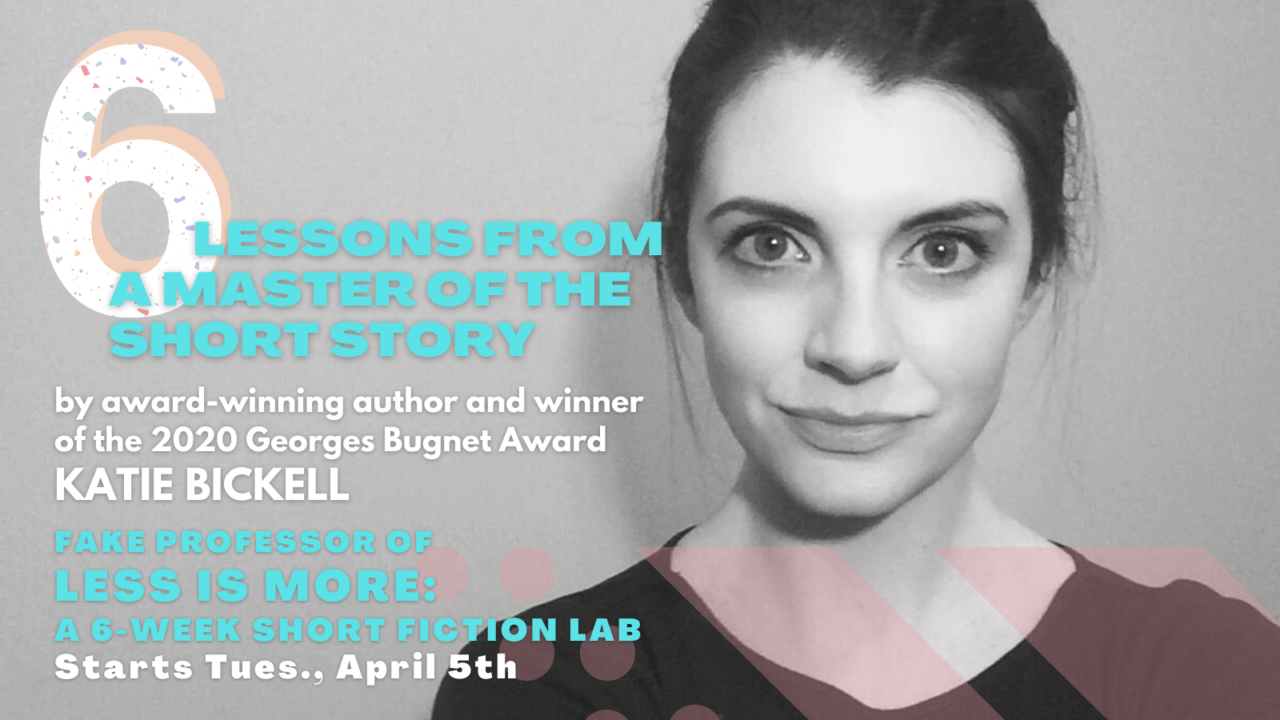Katie Bickell’s “novel-told-in-short-stories,” Always Brave, Sometimes Kind, earned the debut author many accolades, including the Georges Bugnet Award for Fiction. As one of Canada’s most promising new writers and a master of short fiction, she’s joined our faux-culty to bring you Pandemic U’s first ever fiction course.
Starting Tues., April 5th, she’ll teach Less is More: A Six-week Short Fiction Lab. (Capacity is limited, and as of today only 6 seats remain.)
Leading up to her course, we asked Katie to share a few lessons from her decade of mastering this tricky literary form. “As a writer of short stories, I like to keep things organized and brief,” she says. “So, when Pandemic University asked me to share writing tips, I figured I’d share a favourite tip from each of the six classes. I hope they entice you to join me as you pen your next great (short) work.”
1. On Character Creation
Could you catfish someone with your protagonist? I’m not suggesting you try (although the thought of a writing instructor assigning such homework gives me an interesting story idea…), but I am arguing that you should be able to.
To master voice means knowing everything about your protagonist, and it means having a good grasp on the real-life people like your character. This intimate knowing is vital as otherwise the author’s voice tends to slip into the text and breaks the reader’s suspension of disbelief.
If your reader has parented, taught, known, or been a junior high boy and your fourteen-year-old male protagonist uses or even thinks the word “bottom” instead of “ass” while trying to impress friends, your reader is going to roll their eyes and possibly walk away from your story.
2. On Character Development and Narrative Arcs
Good story is all about change. In literature, change is vital for both the external events that make up your story (plot) and the internal personality, values, and/or beliefs of your protagonist (character development). When brainstorming your story, first consider what kind of character arc you plan on the protagonist undertaking.
Pinpoint what you want your character’s inner world to look like at the beginning of the story and at the end of the story. Then, explore what emotion might be strong enough to trigger the change from starting point to end.
You don’t need to know what situation will trigger the emotion yet; you just need to figure out which emotion is most appropriate for your character to experience. To achieve this, you must know your character well enough to have insight into what emotions have the power to transform them.
For example, does your protagonist respond most intensely to shame or jealousy or protectiveness or gratitude or fear? If your character is a warrior who historically laughs in the face of fear, then fear likely won’t be the catalyst that changes him. However, some mixture of guilt, shame, embarrassment, and bewilderment might…
Once you know what feeling your character must experience at the story’s climax, you’ll be able to fashion an external plot point in your narrative arc specifically designed to realistically conjure that emotion.
3. On Story Structure, Pacing, and Scene Transitions
By the end of Class Two, students will have plotted both their character and narrative arc. With three points on this arc, it’s almost intuitive that our short stories will fit neatly into a three-act structure.
However, I suggest writers challenge themselves to stretch their short story outlines into a five-act structure. This allows for a richer narrative and makes for more sophisticated storytelling. It also allows us to investigate how Freytag’s Theory of Play and Counterplay might contribute to the organization of our narrative and reminds us to provide a final force of suspense to keep readers turning pages until the very last word.
Could you catfish someone with your protagonist? I’m not suggesting you try … I am arguing that you should be able to.
4. On Theme
Find your motif. By the time we explore theme in the Less is More Story Lab, students will have created a story scene map. In doing so, it’s likely you will have discovered elements within you story idea that might work as symbols.
The next question is whether a symbol could be built upon to form a motif that serves your story’s theme. Is there a certain object, phrase, memory, or character that could keep popping up in the life of your protagonist? What might this constant thing be, and what will it represent?
Remember that when your protagonist’s perspective or internal experience changes at the story’s climax, their understanding of or feeling toward this motif will also likely change (or, if your character is oblivious, it might be only the reader who realizes the transformation through the story’s subtext).
5. On the Creative Process
This is probably the most important piece of writing advice I can share: Do Not Fear.
Fear is the enemy of creativity, and it hides in our craft without our knowing. Fear is at the root of procrastination, of not bringing oneself to pen the story that already lives inside one’s mind. Fear is at the root of every excellent tale doomed to hard drive invisibility because perfectionism prevents its submission for publication. Fear is at the root of every difficult writing session that instead turns into an easy research marathon. Fear is at the root of every watered-down story that fails to share a glimpse of the human condition, preferring to tiptoe around the pool of truth instead of cannonballing in.
In Class Five, we will strategize on defeating our writerly tendencies towards fear. Or, at least, we will explore ways in which we can trick ourselves into quiet courage.
6. On Revision
The thing about short stories is they’re well… short. In a short story every single word should pay rent.
That means sentences must be interrogated on a microlevel. It means never using two words where one would suffice. It means removing whole paragraphs that are stunning in prose, imagery, and flow, but that fail to deepen character development, support theme, or advance the plot. It means knowing the difference between what backstory is vital for the author to have written and read, and what the reader needs to know.
It also means killing your darlings and editing ruthlessly.
Are you interested in taking Katie’s short fiction course? Here’s what you need to know!
COURSE SCHEDULE: Tuesdays, April 5 – May 17, 2022, 4pm–6pm PT / 7pm–9pm ET*
* There is a two-week break between classes 5 and 6 to allow for time to write your first draft.
In this six-week course, author Katie Bickell will show writers how to apply those various techniques to their own story, as they develop it in class. Through lectures, group discussions, and activities, she’ll guide each of them from conception to early draft editing, along the way learning how to improve their work’s themes, subtext, plot, character development, story architecture, and the writer’s own relationship to creativity.
This is an interactive course designed for emerging literary fiction writers in the pre-publication or early publication stages of their career. Homework will be assigned weekly and students can expect to complete the course with the tools needed to pen a well-crafted short story. Students will complete a first draft and receive feedback from their instructor and classmates; following the course, they’re also invited to submit final drafts to Katie for individual feedback at no additional cost.
This course is intended for beginner and emerging fiction writers committed to completing a short story while strengthening their crafting skills through a comprehensive understanding of the elements of short fiction. The seed of a story idea or the vague image of a character you’d like to develop will likely be valuable in the early weeks. If you’re unsure whether this course is for you, ask us at info@pandemicuniversity.com.

